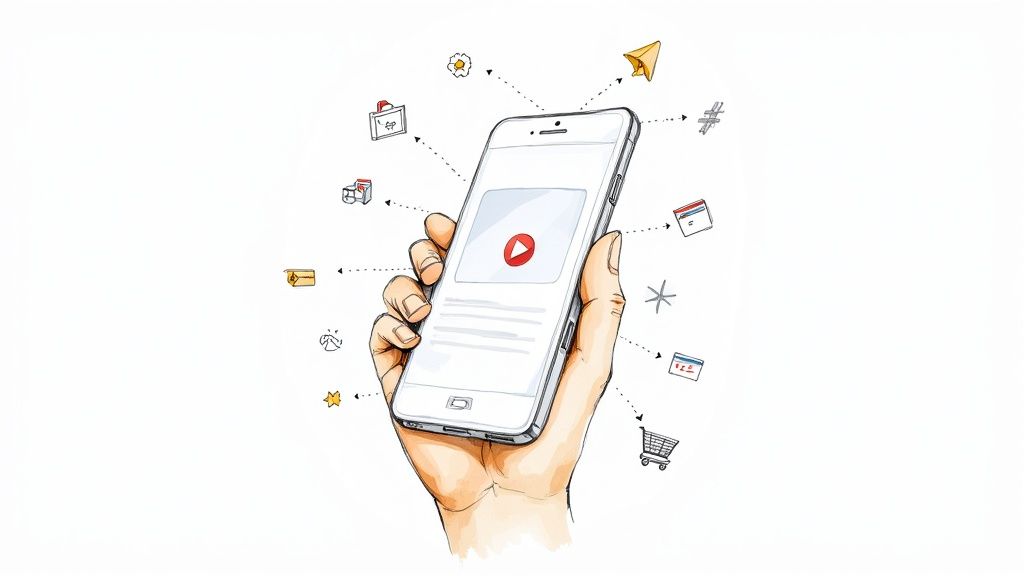
Your Guide to Video E Commerce Success
Simply put, video e commerce is all about using video to sell products directly to your audience. It’s a strategy that turns someone just watching a video into an active shopper by placing things like "buy now" buttons right inside the video player. This makes the leap from seeing something you like to buying it almost instantaneous.
What Is Video E Commerce Really?
Let’s dig a little deeper than that simple definition.
Picture traditional e-commerce. It’s a lot like flipping through a static product catalog. It's functional, sure, but it’s flat. You’re looking at pictures and reading descriptions, but there's no life to it. You're just browsing.
Video e commerce, on the other hand, is like having a personal shopping assistant right there with you, showing you exactly how a product works, how it feels, and how it can fit into your life. It transforms that passive browsing into an engaging, active shopping experience. This is where static product pages get a major upgrade, evolving into dynamic, story-driven showcases that really grab attention and drive sales.
Bridging the Gap Between Browsing and Buying
The real magic of video e commerce is its power to shrink the customer journey. Instead of a customer seeing an ad, clicking to a website, searching for the product, and then finally adding it to their cart, they can do it all right from the video player itself.
This isn't just a fleeting trend; it's a genuine shift in how we sell online. The global video commerce market is absolutely exploding. It's projected to hit an incredible USD 14,401.8 billion by 2034, rocketing up from USD 917.4 billion in 2024. That’s a compound annual growth rate (CAGR) of 31.7%. This massive growth is being driven by the undeniable power of video to show products in action through reviews and demos, both on e-commerce sites and all over social media. You can explore the full market analysis to get a sense of this incredible momentum.
This infographic gives you a great visual on the key business metrics that video e commerce directly boosts.
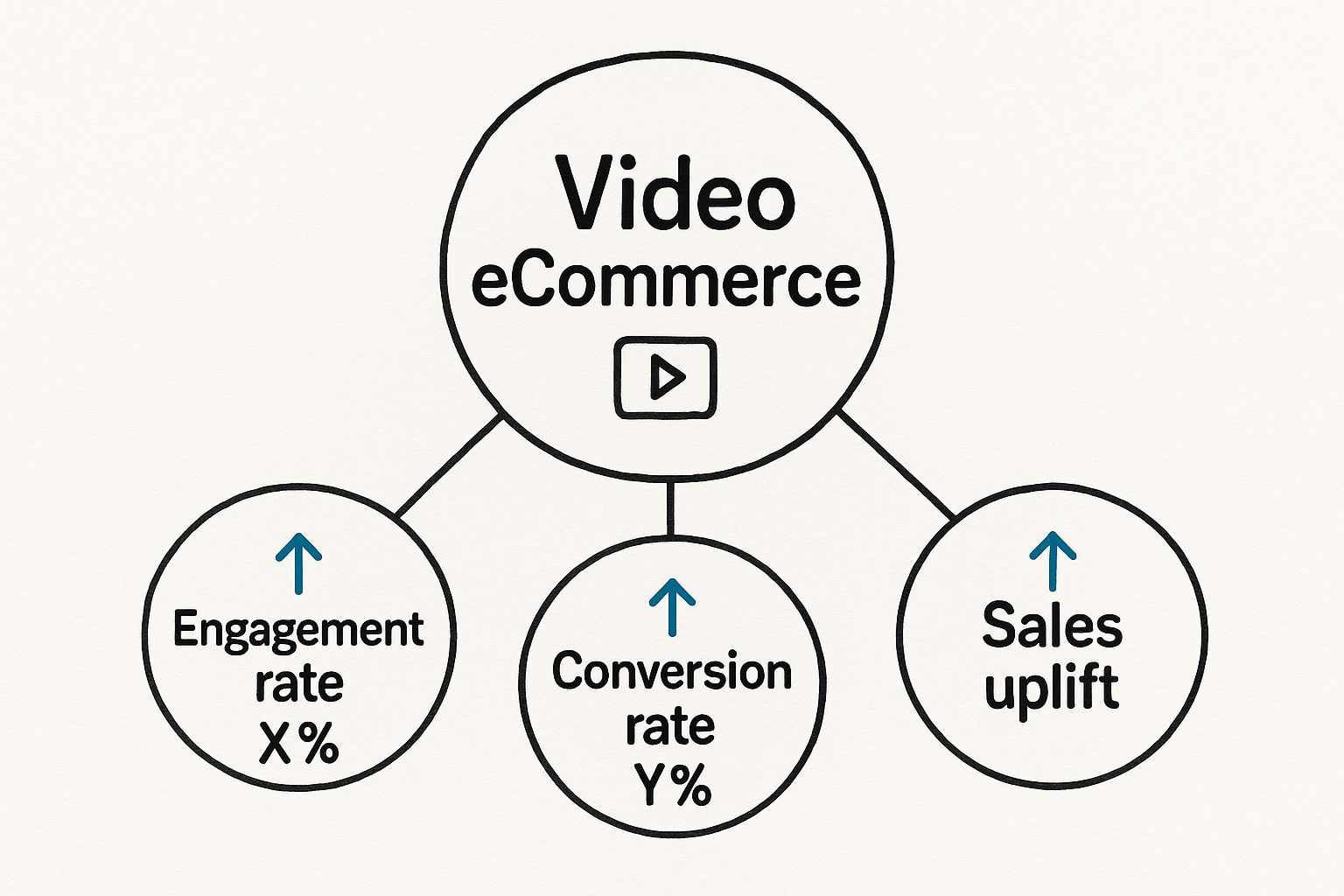
As you can see, bringing a solid video strategy into the mix leads to real, measurable wins across the board—from engagement and conversions to bottom-line sales.
Traditional Commerce vs Video E Commerce at a Glance
To really get a feel for this shift, it helps to see the old and new ways of selling side-by-side. The table below breaks down the key differences in how customers engage, get information, and ultimately decide to buy.
At the end of the day, video e commerce is about meeting modern customers where they already are: watching videos. By making those videos shoppable, brands are creating a more natural, satisfying, and effective sales channel that just clicks with today's digital habits. It’s about selling through compelling stories, not just static product listings.
Why Video Content Is Dominating Online Retail
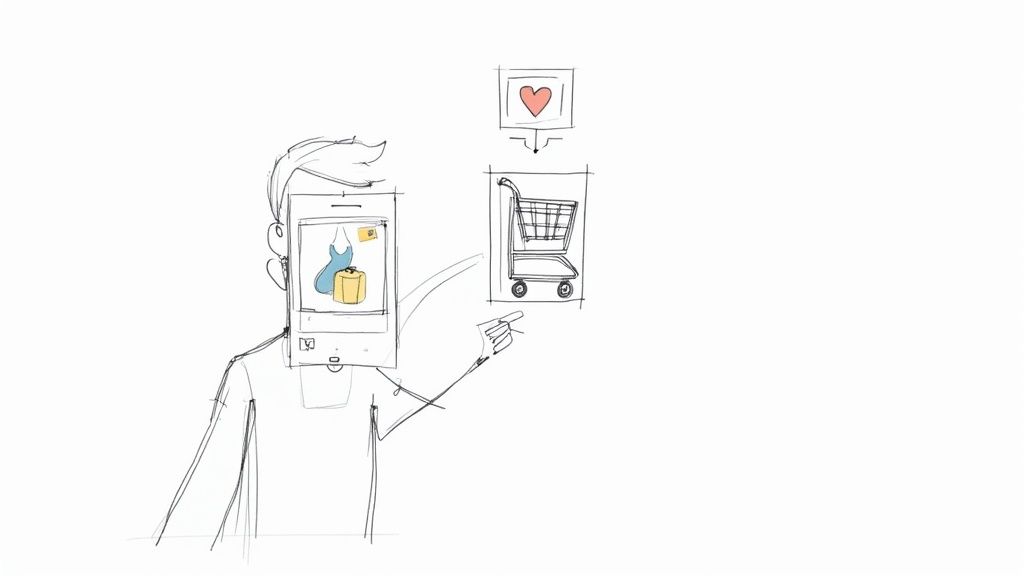
To really get why video e-commerce is taking over, you have to look at a simple, fundamental truth about how we're wired. Our brains just love motion and stories. Static images and big blocks of text? They require us to do the heavy lifting. But video? It serves up information dynamically, making it far easier and genuinely more fun to absorb.
Let’s put it this way: a product description can tell you about a dress, but a video shows you how the fabric moves, how it drapes on a real person, and what it might feel like to wear it. This creates a much deeper, more emotional connection that plain text just can't replicate. It's the difference between reading a recipe and watching a chef bring that meal to life right in front of you.
This isn't just a hunch; the data is overwhelming. Video now accounts for nearly 83% of all internet traffic across the globe. That’s a staggering number that proves just how much command this medium has over our digital lives.
The New Standard for Product Discovery
This massive shift didn't happen in a vacuum. It was kicked into high gear by social media platforms that have completely rewired what we expect as consumers. Short, authentic video clips are now the gold standard for how we discover new products and make buying decisions.
The rise of video-first platforms has fundamentally changed the rules of online retail. Authenticity and visual storytelling are no longer just nice-to-haves; they are the primary drivers of consumer trust and purchasing decisions.
Platforms like Instagram and TikTok have trained an entire generation of shoppers to seek out content that's quick, engaging, and feels real. That old-school, polished corporate ad is being pushed aside for user-generated reviews, behind-the-scenes peeks, and snappy tutorials. It's impossible to ignore the impact of TikTok for ecommerce, where a single compelling video can make a product go viral practically overnight.
Why Integration Is No Longer Optional
For any e-commerce brand today, this means that weaving video into your strategy isn't just a good idea—it's essential for survival. If you're not adopting a video-first mindset, you're essentially becoming invisible to a huge chunk of your potential audience.
Think about the concrete advantages video brings to the table:
- Builds Unmatched Trust: Seeing a product in action, especially when used by a real person, answers questions and builds confidence in a way that photos simply can't.
- Boosts Engagement and Retention: People are far more likely to remember what they saw in a video compared to what they read in a block of text. This leads to much better brand recall down the line.
- Reduces Purchase Hesitation: Videos are brilliant for showing a product's true size, scale, and function. This dramatically lowers the perceived risk of buying something online and can even help reduce return rates.
In short, video content is dominating online retail because it lines up perfectly with how modern shoppers want to learn, discover, and connect with brands. By embracing video e-commerce, you aren't just chasing a trend. You're adapting to a fundamental shift in how people think and behave, opening up brand new ways to build connections and drive growth.
Which Product Categories Thrive with Video?
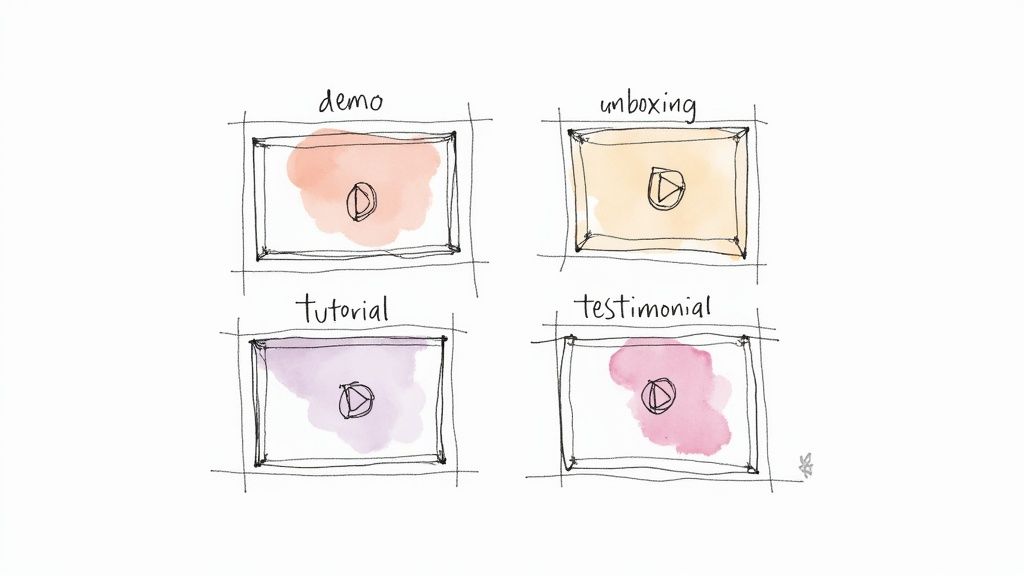
While you could argue that almost any product gets a lift from video, some categories are just a natural fit for video e-commerce. These are the industries where showing is infinitely more powerful than telling—where video closes that critical gap between seeing something online and truly understanding its real-world value.
It's not just a generic boost. For some products, video is the key that unlocks customer confidence and drives the sale.
Think about apparel. A static photo can show you a sweater, but a video shows you how the fabric drapes and moves as a person walks. It reveals the true-to-life fit in a way that just erases guesswork and, as a result, helps cut down on returns. This is exactly why the apparel industry is such a dominant force in this space.
The market data backs this up completely. By 2028, the video commerce market is projected to hit a massive USD 2.8 trillion. And leading the charge is apparel, poised to capture 35% of the market share simply because fashion is so visual. If you want to dig deeper, you can explore more detailed market size predictions to really grasp the scale of this opportunity.
Where Visual Storytelling Drives Sales
Beyond clothing, a few other categories are crushing it with video because it helps them tell a more compelling product story. Each one uses video to solve a specific problem that comes with online shopping, making the whole experience feel more tangible and trustworthy.
- Beauty and Personal Care: This sector, making up 30% of the market, is all about transformation. Makeup tutorials with a clear before-and-after, or a skincare routine that shows the product's texture and application, are incredibly persuasive.
- Electronics and Gadgets: Accounting for 15% of the market, electronics are often packed with complex features. A quick demo video can demystify a new gadget, showing off its functionality far better than a dense spec sheet ever could.
- Home Goods and Furniture: Video helps customers visualize how things fit. Seeing a couch in a fully decorated room or watching a home appliance in action gives shoppers the context they need to click "buy" without hesitation.
The most successful video e-commerce strategies don't just display a product; they demonstrate a result. Whether it’s a perfect fit, a flawless makeup application, or a seamlessly working gadget, video shows the customer the outcome they’re looking for.
This focus on the result is what makes the technology so powerful. By making these visual stories instantly shoppable, you connect the viewer's moment of inspiration directly to the point of purchase.
To see how this works in practice, you can learn more about building an interactive shoppable video that turns passive views into active sales. For brands in these visually-driven categories, getting this right isn't just an advantage—it's the future of online retail.
Creating Shoppable Videos That Convert
Knowing why video commerce works is one thing. Actually creating videos that drive sales? That’s a whole different challenge.
Success isn't about having the biggest budget or the slickest production crew. It's about understanding the core principles that turn a passive viewer into an enthusiastic customer. You have to build a frictionless path from discovery to purchase, making the "buy now" moment feel like a natural next step, not a jarring interruption. This means prioritizing the viewer's experience, focusing on authenticity, and delivering immediate value.
Keep It Short and Mobile-First
In the world of video commerce, attention is your most valuable currency. Your audience is scrolling through endless feeds, so your content has to grab them instantly. That means keeping videos concise and designing them for the device they're almost certainly using: their smartphone.
- Aim for Brevity: For social media ads and general promotions, try to keep videos under 90 seconds. Product demos can run longer if they're packed with value, but your hook needs to land within the first three seconds.
- Design for Vertical Viewing: Most people watch videos on their phones, and they rarely turn them sideways. Shoot and edit in a vertical (9:16) aspect ratio to fill the entire screen and create a more immersive experience.
- Assume Sound-Off Viewing: A huge number of people watch videos with the sound off. Use clear on-screen text, captions, and strong visuals to make sure your message hits home even in complete silence.
Authenticity Outperforms Polish
Today’s shoppers are sharp. They can spot a stuffy corporate ad from a mile away and are far more likely to trust content that feels genuine and relatable.
Sometimes, this means that simple, behind-the-scenes videos or content from your actual customers (UGC) can be far more powerful than a high-gloss production.
The best video content doesn’t feel like an ad at all. It feels like a helpful recommendation from a friend, building social proof that makes your product irresistible.
Embrace content that shows real people using and loving your products. Encourage your customers to share their own videos and feature them on your channels. This raw, authentic footage builds a layer of trust that polished marketing often struggles to achieve. To see just how powerful this can be, you can learn more about how shoppable videos can boost your e-commerce business in a big way.
Create a Seamless Path to Purchase
This is the final, most crucial step: making your video shoppable. All the views and likes in the world mean very little if a viewer can't easily act on their impulse to buy.
This is where interactive elements become a game-changer. The goal is to close the gap between inspiration and transaction—instantly. For a deeper look at the nuts and bolts, our guide on how to create interactive video offers step-by-step instructions.
By embedding clickable hotspots, product tags, or "Add to Cart" buttons directly into your video, you create a seamless shopping experience that converts viewers right when they're most engaged.
How to Make Your Videos Shoppable with Mindstamp
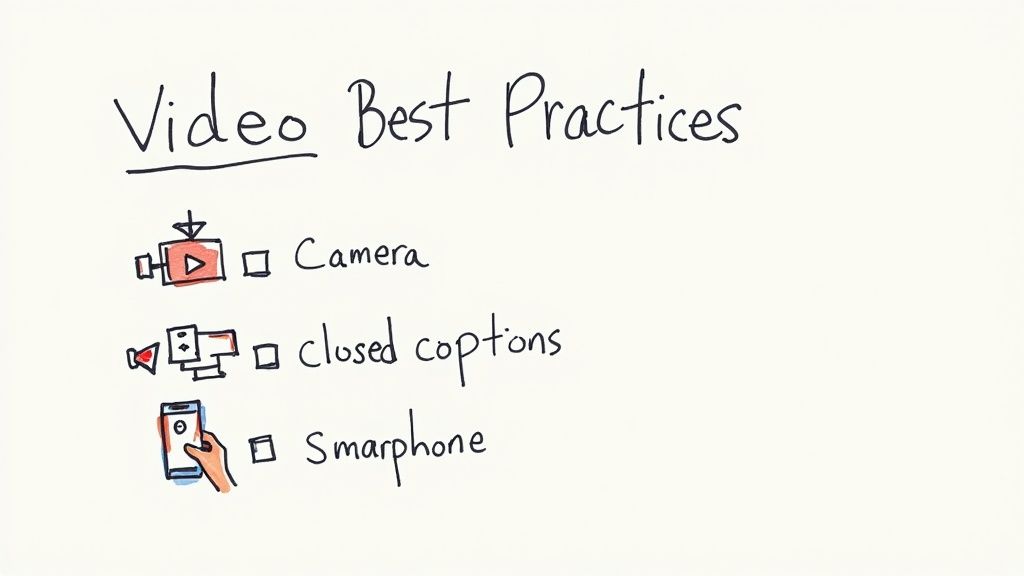
Knowing you should use video e-commerce is one thing. Actually making it happen is another. This is where a tool like Mindstamp comes in, bridging the gap between a great idea and getting it done. It lets you transform your standard videos into powerful, interactive sales channels—no coding skills required.
The whole point is to make the shopping experience as immediate and seamless as possible. You can think of Mindstamp as an interactive layer you place right on top of your existing video content. This layer allows you to embed clickable elements directly into the video player, turning someone from a passive viewer into an active, engaged customer on a path to purchase.
Just look at the Mindstamp interface. It’s designed to be intuitive, showing you how easy it is to add things like buttons and hotspots to your video timeline. With a simple, user-friendly editor, you can pinpoint the exact moment you want a call to action to appear, making sure it’s perfectly timed with what's happening on screen.
Turning Viewers into Buyers with a Click
The most direct way to drive sales from your videos is to make the products people see instantly shoppable. Mindstamp gives you a few key ways to do this, creating a frictionless path from "I like that" to "I bought that."
- Clickable Product Hotspots: You can place a small, noticeable icon or "hotspot" right over a product as it’s featured in your video. When a viewer clicks it, a pop-up can show more details, display the price, and link straight to the product page.
- Embedded 'Add to Cart' Buttons: Want to make it even easier? Add an "Add to Cart" button that appears at the perfect moment. This click can add the item to a customer's shopping cart without them ever having to leave the video. That’s how you reduce friction.
The goal is to capture buying intent the second it strikes. By placing the purchase opportunity directly within the video, you eliminate the extra steps that cause so many potential customers to drop off.
Measure What Matters and Optimize
Adding buttons is just the start. A true video e-commerce platform gives you the data you need to understand what's actually working. Mindstamp provides detailed analytics on viewer engagement, showing you precisely which parts of your video people are watching, re-watching, or skipping entirely.
You can track how many viewers click on your product hotspots or buttons, giving you a clear view of the ROI on your video content. This data is pure gold for refining your strategy and helping you create more effective videos over time. For instance, if you notice a big spike in clicks right after you mention a specific product benefit, you know to lean into that feature in your future content.
A strong call to action is fundamental to all of this. You can learn more about the importance of adding a CTA to videos in our detailed guide.
Ultimately, Mindstamp makes sophisticated video e-commerce accessible, allowing any brand to create engaging, measurable, and shoppable experiences that drive real results.
The Future of Video E Commerce
The world of video e-commerce is moving at a breakneck pace. If you think today's shoppable videos are impressive, what's coming next will make them look like a warmup act. The next wave isn't just about adding a 'buy' button; it's about creating experiences that are deeply personal, incredibly immersive, and just plain entertaining.
Imagine a video that changes just for you. That's the core idea behind AI-driven personalization. The products shown, the deals offered, and even the story the video tells could shift in real-time based on your past purchases, where you're watching from, or what you've shown interest in before. This creates a completely unique experience for every single viewer. As video commerce matures, delivering these one-of-a-kind shopping journeys will be essential. Getting a handle on mastering personalized shopping experiences is the key to meeting these new customer expectations.
Immersive and Live Experiences
Beyond just personalization, the real excitement lies in blurring the lines between retail, entertainment, and immersion. This is where some truly forward-thinking technologies are set to completely change how we shop.
- Live Shopping Events: Think of it as QVC for the social media generation. Brands are now hosting live-streamed events with hosts, influencers, and product experts who chat with the audience, answer questions on the fly, and drop exclusive deals. It creates a powerful sense of community and urgency.
- Augmented Reality (AR): AR is poised to bring virtual "try-before-you-buy" experiences straight into a video. With just your phone, you could see how a new couch looks in your living room or how a pair of sunglasses fits your face, all without leaving the video player.
The next frontier of video e-commerce isn’t just showing the product; it's about letting the customer experience it. This shift from passive viewing to active participation will build deeper connections and drive unparalleled conversion rates.
At the end of the day, all these advancements are creating a much more dynamic and engaging way to shop. The lines between content, community, and commerce are fading fast, making the entire process feel less like a transaction and more like a fun, personalized journey.
Common Questions About Video E-Commerce
Diving into any new sales strategy brings up a lot of questions. We get it. When brands start exploring video e-commerce, a few common ones almost always pop up. Getting those answered upfront is the best way to move forward confidently and sidestep any early hurdles.
Here are the answers to some of the most frequent questions we hear from businesses ready to make the jump.
How Much Does It Cost to Start?
This is the big one, and the answer is: it varies, but probably a lot less than you think. You don't need a Hollywood budget to get started. In fact, you can kick things off with just your smartphone and some decent lighting. This approach creates authentic, user-generated-style content that really connects with today's shoppers.
Of course, if you want a more polished, high-production look, the costs will go up. The smartest move, however, is to first invest in a platform that makes any video you have shoppable. That way, you’re getting the most out of video assets you already own (or new ones you create) without a massive upfront technology cost.
What Kind of Videos Work Best?
Time and again, we see that the most effective videos are the ones that feel real and offer genuine value. While there's room for creativity, a few formats are consistent winners:
- Product Demos: Show, don't just tell. Seeing your product in action clears up questions and builds a ton of confidence.
- How-To Guides & Tutorials: Teach your audience something useful that involves your product. This builds authority and keeps them coming back.
- Customer Testimonials: Nothing beats social proof. Let your happy customers do the selling for you.
- Unboxing Videos: Tap into the excitement of getting something new. It’s a simple format that captures a powerful feeling.
As a rule of thumb, shorter videos—usually under 90 seconds—are perfect for social media feeds. For your product pages, you can go longer with more in-depth content.
Do I Need to Be on Camera?
Not at all. While having a founder or team member on screen can forge a really strong connection with your audience, it's definitely not a requirement. Plenty of high-impact videos don't feature a single person.
The real goal is to clearly show your product’s value and benefits. The message is always more important than the messenger.
You could create animated explainer videos, use screen recordings to demo a digital product, or even team up with influencers and customers to feature their content. The possibilities are wide open.
Ready to turn your videos into your most powerful sales channel? With Mindstamp, you can easily add clickable hotspots, ‘Add to Cart’ buttons, and track every interaction to see exactly what drives conversions. Start creating shoppable experiences that captivate your audience and grow your business today. Explore Mindstamp's interactive video platform.
Get Started Now
Mindstamp is easy to use, incredibly capable, and supported by an amazing team. Join us!



Try Mindstamp Free










